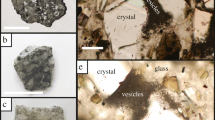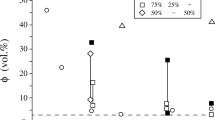Abstract
Peralkaline silicic welded ash-flow tuffs differ characteristically in a number of properties from most calc-alkaline welded tuffs, due to their generally lower viscosity and higher temperatures.
For example, individual cooling units are relatively small (less than 30 m thick, less than 5 km3 in volume); rocks can be thoroughly welded and crystallized to feldspar, quartz, and mafic minerals; several primary deformational structures (e.g. lineations, stretching of pumice, folds, ramp structures) indicate late stage laminar creep, resulting from the low yield strength of the nearly homogeneous glass of very low viscosity.
Theoretical considerations also suggest that peralkaline melts are of low viscosity and high temperature, as inferred from,e.g., their chemical composition (high iron- and alkali-, and low alumina-concentrations). The low viscosity may also be due to trapping of volatiles.
Absence or paucity of OH-bearing phenocryst phases, paucity of pyroclastic rocks, other than ash flow tuffs, formed from highly explosive eruptions, and apparently high crystallization temperatures, indicate that peralkaline silicic magmas are comparatively dry. The common occurrence of peralkaline ash-flow tuffs may be due to an increased water content of the magmas, resulting also in amphibole phenocrysts in some welded tuffs, or to specific volcanotectonic conditions.
Ash flows of peralkaline composition move as particularly dense particulate flows. This type of flowage and the very rapid welding of the low viscosity glass lead to a high degree of homogenization of the fine glass shards. This in turn inhibits complete degassing of the collapsing ash flow. Semiclosed systems result where gas overpressures can develop and where volatiles play an important role by fluxing crystallization and transporting dissolved matter.
Several types of vesicles can form under these conditions: (a) Spherical vesicles within collapsed ash and pumice particles formed after deposition of the ash flow. (b) Round or irregular vesicles transsecting pyroclastic particles, vesicle sheets, and large cavities, several m in diameter, may form in a largely homogenized ash-flow tuff beneath tightly welded layers. (c) Lensoid cavities formed during granophyric crystallization of large pumice particles. Small ash particles of peralkaline composition may assume spherical shapes due to their low viscosity and in some cases, expansion of bubbles. They form during transport and are preserved under low load pressure in the top part of cooling units. Globule lavas and most froth flows are interpreted as welded ash-flow tuffs, some of their unusual features being due to their peralkaline composition.
Similar content being viewed by others
Author information
Authors and Affiliations
Rights and permissions
About this article
Cite this article
Schmincke, H.U. Volcanological aspects of peralkaline silicic welded ash-flow tuffs. Bull Volcanol 38, 594–636 (1974). https://doi.org/10.1007/BF02596900
Received:
Issue Date:
DOI: https://doi.org/10.1007/BF02596900




